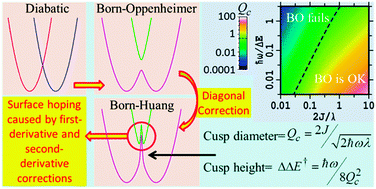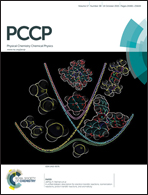Non-adiabatic effects in thermochemistry, spectroscopy and kinetics: the general importance of all three Born–Oppenheimer breakdown corrections†
Abstract
Using a simple model Hamiltonian, the three correction terms for Born–Oppenheimer (BO) breakdown, the adiabatic diagonal correction (DC), the first-derivative momentum non-adiabatic correction (FD), and the second-derivative kinetic-energy non-adiabatic correction (SD), are shown to all contribute to thermodynamic and spectroscopic properties as well as to thermal non-diabatic chemical reaction rates. While DC often accounts for >80% of thermodynamic and spectroscopic property changes, the commonly used practice of including only the FD correction in kinetics calculations is rarely found to be adequate. For electron-transfer reactions not in the inverted region, the common physical picture that diabatic processes occur because of surface hopping at the transition state is proven inadequate as the DC acts first to block access, increasing the transition state energy by (ℏω)2λ/16J2 (where λ is the reorganization energy, J the electronic coupling and ω the vibration frequency). However, the rate constant in the weakly-coupled Golden-Rule limit is identified as being only inversely proportional to this change rather than exponentially damped, owing to the effects of tunneling and surface hopping. Such weakly-coupled long-range electron-transfer processes should therefore not be described as “non-adiabatic” processes as they are easily described by Born–Huang ground-state adiabatic surfaces made by adding the DC to the BO surfaces; instead, they should be called just “non-Born–Oppenheimer” processes. The model system studied consists of two diabatic harmonic potential-energy surfaces coupled linearly through a single vibration, the “two-site Holstein model”. Analytical expressions are derived for the BO breakdown terms, and the model is solved over a large parameter space focusing on both the lowest-energy spectroscopic transitions and the quantum dynamics of coherent-state wavepackets. BO breakdown is investigated pertinent to: ammonia inversion, aromaticity in benzene, the Creutz–Taube ion, the bacterial photosynthetic reaction centre, BNB, the molecular conductor Alq3, and inverted-region charge recombination in a ferrocene–porphyrin–fullerene triad photosynthetic model compound. Throughout, the fundamental nature of BO breakdown is linked to the properties of the cusp catastrophe: the cusp diameter is shown to determine the magnitudes of all couplings, numerical basis-set and trajectory-integration requirements, and to determine the transmission coefficient κ used to understand deviations from transition-state theory.


 Please wait while we load your content...
Please wait while we load your content...